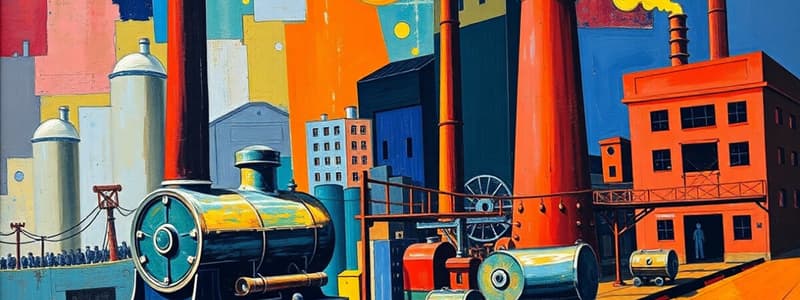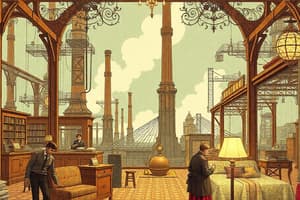Podcast
Questions and Answers
Protective tariffs are taxes on domestic exports, designed to raise government revenue.
Protective tariffs are taxes on domestic exports, designed to raise government revenue.
False (B)
The factory system primarily used hand-powered machines and hired skilled laborers.
The factory system primarily used hand-powered machines and hired skilled laborers.
False (B)
A free enterprise system includes heavy government control over businesses.
A free enterprise system includes heavy government control over businesses.
False (B)
Push factors for migration include things like freedom and economic opportunity.
Push factors for migration include things like freedom and economic opportunity.
The cotton gin decreased cotton production but decreased the need for slave labor.
The cotton gin decreased cotton production but decreased the need for slave labor.
The mechanical reaper and the thresher sped up harvesting and processing wheat in the South.
The mechanical reaper and the thresher sped up harvesting and processing wheat in the South.
The steel plow was designed to easily cut through the sandy soils of the East.
The steel plow was designed to easily cut through the sandy soils of the East.
The telegraph allowed for near-instantaneous long distance communication.
The telegraph allowed for near-instantaneous long distance communication.
The rise of nationalism, the downfall of the Federalist Party, and a reduction in manufacturing were all changes seen at the start of the Industrial Revolution in the US.
The rise of nationalism, the downfall of the Federalist Party, and a reduction in manufacturing were all changes seen at the start of the Industrial Revolution in the US.
Fast-flowing rivers in the South provided essential power for early factories.
Fast-flowing rivers in the South provided essential power for early factories.
The Industrial Revolution led to some women moving to cities for factory work, which increased their financial independence.
The Industrial Revolution led to some women moving to cities for factory work, which increased their financial independence.
Improved transportation and communication resulted in faster, cheaper ways to move goods and more people moving west, along with better connection with those back home using the typewriter.
Improved transportation and communication resulted in faster, cheaper ways to move goods and more people moving west, along with better connection with those back home using the typewriter.
Population decline provided a larger workforce for factories and less immigrants looking for cheap or any work.
Population decline provided a larger workforce for factories and less immigrants looking for cheap or any work.
In a Free Enterprise system, the government plays a large role in overseeing the type and amounts of goods to produce.
In a Free Enterprise system, the government plays a large role in overseeing the type and amounts of goods to produce.
Industrial Revolution inventions discouraged westward expansion because people had less incentive to leave the city.
Industrial Revolution inventions discouraged westward expansion because people had less incentive to leave the city.
German immigrants primarily worked in factories in the North and did not open their own shops or businesses in America.
German immigrants primarily worked in factories in the North and did not open their own shops or businesses in America.
Irish immigrants primarily settled in the southern United States.
Irish immigrants primarily settled in the southern United States.
Many German immigrants came to the United States seeking economic opportunities.
Many German immigrants came to the United States seeking economic opportunities.
Chinese immigrants were primarily employed in agriculture in the West.
Chinese immigrants were primarily employed in agriculture in the West.
The case of Marbury vs. Madison established the principle of judicial review.
The case of Marbury vs. Madison established the principle of judicial review.
The Gibbons vs. Ogden court case defined that interstate commerce is handled by the state governments.
The Gibbons vs. Ogden court case defined that interstate commerce is handled by the state governments.
The southern economy supported the use of tariffs, relying on paid laborers, and railroads.
The southern economy supported the use of tariffs, relying on paid laborers, and railroads.
The northern economy heavily supported an agricultural economy with limited use of banks.
The northern economy heavily supported an agricultural economy with limited use of banks.
The plantation system saw an increase in the speed of cotton production due to the cotton grin.
The plantation system saw an increase in the speed of cotton production due to the cotton grin.
Flashcards
Protective Tariffs
Protective Tariffs
Taxes on foreign imports to raise government revenue and protect U.S. businesses.
Factory System
Factory System
Manufacturing method using water-powered machines to produce textiles.
Free Enterprise System
Free Enterprise System
Economic system with minimal government interference and competition among businesses.
Urbanization
Urbanization
Signup and view all the flashcards
Mass Production
Mass Production
Signup and view all the flashcards
Sectionalism
Sectionalism
Signup and view all the flashcards
Interchangeable Parts
Interchangeable Parts
Signup and view all the flashcards
Telegraph
Telegraph
Signup and view all the flashcards
Causes of the Industrial Revolution
Causes of the Industrial Revolution
Signup and view all the flashcards
Geographic features of New England
Geographic features of New England
Signup and view all the flashcards
Women and the Industrial Revolution
Women and the Industrial Revolution
Signup and view all the flashcards
Transportation and Communication Improvements
Transportation and Communication Improvements
Signup and view all the flashcards
Population Growth Impact
Population Growth Impact
Signup and view all the flashcards
Free Enterprise System Government Role
Free Enterprise System Government Role
Signup and view all the flashcards
Inventions Encouraging Westward Expansion
Inventions Encouraging Westward Expansion
Signup and view all the flashcards
Immigration Contributions in 1800s
Immigration Contributions in 1800s
Signup and view all the flashcards
Irish Immigration
Irish Immigration
Signup and view all the flashcards
German Immigration
German Immigration
Signup and view all the flashcards
Chinese Immigration
Chinese Immigration
Signup and view all the flashcards
Marbury vs. Madison
Marbury vs. Madison
Signup and view all the flashcards
McCulloch vs. Maryland
McCulloch vs. Maryland
Signup and view all the flashcards
Gibbons vs. Ogden
Gibbons vs. Ogden
Signup and view all the flashcards
North Economy
North Economy
Signup and view all the flashcards
Southern Economy
Southern Economy
Signup and view all the flashcards
Study Notes
Vocabulary
- Protective Tariffs: Taxes on foreign imports, used to fund the government and shield American businesses from foreign competition.
- Factory System: Utilized water-powered machines to produce textiles, employing unskilled laborers.
- Free Enterprise System: An economic system characterized by competition between businesses, individual freedom of trade, and minimal government interference.
- Textiles: Cloth products.
- Urbanization: The growth of cities.
- Mass Production: Manufacturing large quantities of products.
- Efficient: Maximum productivity with minimal effort.
- Push Factors: Factors leading people to leave a region (e.g., population growth, poverty, famine, political or religious conflict).
- Pull Factors: Factors drawing people to a region (e.g., economic opportunity, freedom, abundant land).
- Sectionalism: Devotion to a particular region over the nation as a whole.
Industrial Revolution Inventions
- Interchangeable Parts: Allowed for easier assembly, repair, and replacement of machine parts, boosting manufacturing efficiency and affordability.
- Steamboats and Canals: Facilitated faster and cheaper upstream transportation, boosting trade and connecting regions of the country, particularly the North and West.
- Telegraph: Enabled near-instantaneous long-distance communication, revolutionizing communication and connecting distant parts of society.
- Cotton Gin: Significantly increased cotton production in the South by rapidly separating cotton seeds from the fibers, leading to a dramatic increase in cotton production and expanding the demand for slave labor.
- Mechanical Reaper and Thresher: Increased the efficiency of harvesting and processing wheat.
- Steel Plow: Made farming in the West easier by making it easier to plow the thick, hard soil, and enabled rapid expansion into new agricultural lands.
- Railroads and Trains: Fastest form of transportation to connect cities in the North, enabling rapid movement of goods and people.
War of 1812 Effects
- Increased nationalism, a decline in the Federalist Party's influence, and a boost to American manufacturing and industrialization.
Industrial Revolution Causes
- Increased American desire for independence from relying on imported goods.
- Population growth provided a workforce.
- Technological advancements changed the ways goods were made.
New England Geographic Features and Factories
- Fast-flowing rivers provided power for early factories.
Women's Lives and Factories
- Women moved to urban areas to work in factories and gain economic independence.
Transportation and Communication Improvements
- Quicker, cheaper, and easier product transportation.
- Improved communication enabled greater connection among people.
- Greater willingness for people to move out West due to easier transportation and communication.
Population Growth and Industrial Revolution
- Provided a large labor force for factories.
- Increased demand for products promoted industrialization.
- Immigrants provided cheap labor, especially in the North.
Role of Government in Free Enterprise System
- Limited government intervention in economic affairs.
- Freedom of production, sale, and purchase.
Industrial Revolution and Westward Expansion
- Improved transportation allowed for cheaper and easier movement of people and goods to the West, which encouraged westward expansion.
- Inventions such as the steel plow, mechanical reaper, and thresher enabled efficient wheat production in the West, further stimulating westward expansion.
Erie Canal's Impact
- Promoted growth of towns and cities along routes, boosting development.
Immigration Contributions
- Irish provided cheap labor for factories and canal construction.
- Germans opened businesses and farms in the North and West.
- Chinese provided labor in railroad construction and other industries in the West.
Early U.S. Court Cases
- Marbury v. Madison: Established judicial review.
- McCulloch v. Maryland: Federal law takes precedence over state law.
- Gibbons v. Ogden: Federal government manages interstate commerce.
Sectionalism and Economies
- North: Reliance on tariffs, industry, and paid labor.
- South: Dependence on agriculture and slave labor, opposing tariffs.
- West: Agriculture and support for tariffs for railroad construction.
Plantation System Equation
- High demand for cotton (from Europe and North)
- Cotton gin increased cotton production speed.
- Southern farmers increased cotton fields to meet demands, leading to a need for more workers.
- Slave labor use in the South increased greatly.
Studying That Suits You
Use AI to generate personalized quizzes and flashcards to suit your learning preferences.




